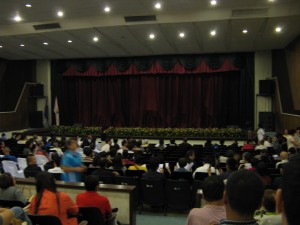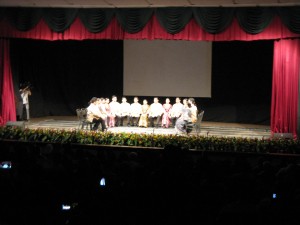
Audience Navigation
Utility Navigation
Student Blogs
University of the Philippines College of Music turns 50!
 Tuesday night was the 50th anniversary celebration concert of the University of the Philippines College of Music.
Tuesday night was the 50th anniversary celebration concert of the University of the Philippines College of Music.
The College of Music was built on a grant from the United States Agency for International Development. Founded as a follow up to the Marshall Plan in 1961, this government agency is responsible for numerous development programs in economics, infrastructure, government, and education. With the 1 million dollar grant in hand, then University of the Philippines President, Carlos P. Romulo authorized the construction of this music center, called Abelardo Hall, named for Nicanor Abelardo, one of the first national composers of the Philippines. Abelardo Hall’s concert stage was one of the first air-conditioned public venues and its academic buildings boast a 1960’s modern minimalist structure previously unseen in the Philippines. Today, the history of Abelardo Hall remains a key part of the US-Filipino relations in terms of bilateral cooperation toward education.
As a Fulbrighter partnering with the College I was allowed to attend and I was thoroughly impressed. The performance offered a wide variety of music and ensembles from symphonic band to soloists to chamber works. The works they played ranged from Bach to music so recent that the ink was drying off the page.
I can’t speak about all of the groups given the expansive program (3 hours + with no intermssion) but I would like to draw special attention to some aspects of the program. Included in the concert were two performances of the University of the Philippines’ signature touring group, the Madrigal Singers. An all acapella (unaccompanied vocals) 12 person group, the Madrigal Singers are capable of singing a wide variety of music, all acapella and always seated. Their trademark style of singing in a calm, soothing nature, persistently decked out in Filipinana clothing (traditional Filipino clothing) gives audiences the best musical face of the Philippines.
Also featured were several Filipino composers, I can’t name them all but the ones that struck me the most were Nicanor Abelardo (1893-1934), Rosendo Santos (1922-1992), and Ramon Santos (1941-) (no relation). These are composers who I believe tug away at the curtain to reveal the proverbial ‘Filipino soul’ (inner consciousness of Filipino national culture) through their music. Abelardo was a prominent University of the Philippines composer and the namesake for the Abelardo Hall. His music combined many of the new techniques found in serial composers and other early 20th century composers and combined them with modes (non western major and minor scalar formations) indigenous to the Philippines to create a brand new aesthetic. Rosendo Santos was a prominent composer who trained at the University of the Philippines during the mid 20th century and came to the U.S. His music is far more nostalgic and conventional by 20th century standards but nevertheless is very powerful. One interesting note is that he lived and taught in the Washington D.C. area, which I call home, yet to my surprise I have not met a single Filipino American from the area who knows him. Ramon Santos’ Awit provided a multi-layered chamber work. Awit, tagalog for song, expresses a canvas of emotions and states through expressive melodies (primary musical lines) and highlights notions of the new Philippines of the post-colonial period. Studying with Ramon Santos and hearing his music live offers just that much more satisfaction. Although all three composers from different generations and styles, all three continue this University’s tradition in trying to musically aestheticize the nation, the people, the history, and the environment of the Philippines. Their works are as Filipino as the languages of the Philippines (I say language due to the prominent number of different languages not just the most common dialect of Tagalog).
Overall, this was a very special night for me. Not only was I experiencing first hand the music of the ‘Filipino soul,’ but I was constantly reminded of the ongoing friendship between the United States and the Philippines. The night in a way helped to sum up my whole experiences in the Philippines. The Hall was built to preserve and foster new musical ideas. Coming to the forefront of these ideas are the musical expressions of the ‘Filipino soul,’ the subject of my research. Even Abelardo Hall’s minimalist structure aesthetically bares a resemblance to my own music, which I credit to a minimalist style. Furthermore, Abelardo Hall was built in cooperation with the U.S. Government, specifically the United States Agency for International Development. That individual snippet hits close to home because my mother works for USAID. This bilateral aqueous solution, the two nations of the Philippines and the United States of America working together, all equate to my experiences in the Philippines as both an Embassy intern and now as a Fulbright scholar. There’s a saying about the friendship and shared goals and ideas between the Philippines and the US: One Mission, One Team (Isang Misyon, Isang Pangkat in Tagalog). Yesterday, when I saw the multitude of talent and innovation that has come from the College of Music and when I see the future talent forthcoming, I truly see a successful mission, a story of continued success of building Filipino culture for future generations.

Paul Fontelo '13
- Studies: History and music double major
- Hometown: Potomac, Md.
- Alumni
- Read more about Paul »
 Emily Castillo '19
Emily Castillo '19
Former Blogger Gianna DiMaiolo '19
Gianna DiMaiolo '19
Former Blogger Brian Senier '19
Brian Senier '19
Former Blogger Amy Casey '18
Amy Casey '18
Former Blogger Michael DeSantis '18
Michael DeSantis '18
Former Blogger Alexandra Larkin '18
Alexandra Larkin '18
Former Blogger Emily Breakell '17
Emily Breakell '17
Former Blogger Haylie Butler '17
Haylie Butler '17
Former Blogger Ellen Chen '17
Ellen Chen '17
Former Blogger Jessica Vozella '17
Jessica Vozella '17
Former Blogger Caroline Keane '17
Caroline Keane '17
Former Blogger Hildie Hoeschen '17
Hildie Hoeschen '17
Former Blogger Elena Ferguson '17
Elena Ferguson '17
Former Blogger Thomas Vignati '17
Thomas Vignati '17
Former Blogger Holly Nord '16
Holly Nord '16
Former Blogger Ali Olson '17
Ali Olson '17
Former Blogger Jonathan Thompson '17
Jonathan Thompson '17
Former Blogger Bryan Rodriguez '17
Bryan Rodriguez '17
Former Blogger Inez Asante '16
Inez Asante '16
Former Blogger LiAnn Butterfield '16
LiAnn Butterfield '16
Former Blogger Lauren Tilmont '16
Lauren Tilmont '16
Former Blogger Mary Zabinski '13
Mary Zabinski '13
Former Blogger Katharine Shapleigh '13
Katharine Shapleigh '13
Former Blogger Kelsey Horton '13
Kelsey Horton '13
Former Blogger Rosemary Henry '14
Rosemary Henry '14
Former Blogger Kevin Gallagher '13
Kevin Gallagher '13
Former Blogger Vivian Daly '13
Vivian Daly '13
Former Blogger Sarah Rondeau '13
Sarah Rondeau '13
Former Blogger Katie Riley '14
Katie Riley '14
Former Blogger Andrew Retallick '14
Andrew Retallick '14
Former Blogger Connor OBrien '16
Connor OBrien '16
Former Blogger Melissa Nelson '10
Melissa Nelson '10
Former Blogger